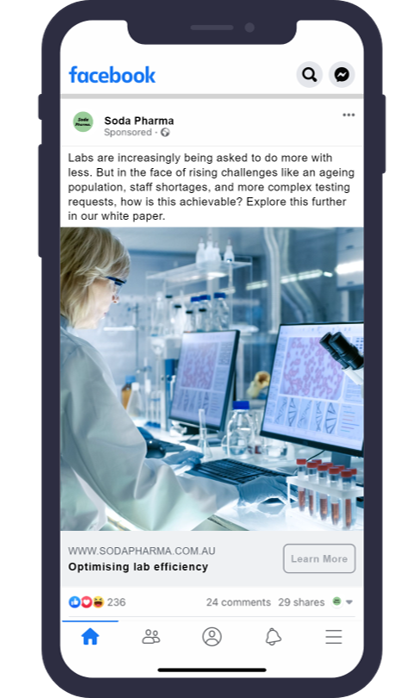Many social media formats will have a character count for the maximum words that will show in post copy before the copy is cut off behind a ‘see more’ truncation. This means you want to front load your post copy and ensure you get a key message or build enough intrigue in before this point. It’s OK to use longer copy to elaborate further, but the first piece of copy needs to be strong enough that people want to open to read more.
It should also be clear to the reader at the outset (whether in the post copy or visual asset) what disease or health topic you are talking about. Otherwise, you risk people scrolling past thinking the post is not relevant to them.
Example: Soda Pharma have a white paper titled ‘Artificial Intelligence in Oncology: Current applications and future opportunities’. They would like to promote this white paper on LinkedIn. Let's look at the post they have developed.
It should also be clear to the reader at the outset (whether in the post copy or visual asset) what disease or health topic you are talking about. Otherwise, you risk people scrolling past thinking the post is not relevant to them.
Example: Soda Pharma have a white paper titled ‘Artificial Intelligence in Oncology: Current applications and future opportunities’. They would like to promote this white paper on LinkedIn. Let's look at the post they have developed.


Tip # 2: Problem. Agitate. Solve
This is a copywriting formula that can be effective for social media copy, especially for link driving activities where you want to push traffic to an external web page or drive downloads of a resource. It involves three stages:
This is a copywriting formula that can be effective for social media copy, especially for link driving activities where you want to push traffic to an external web page or drive downloads of a resource. It involves three stages:
- Problem – set up / pose the problem. This is where your audience persona comes in handy, think about the problems / pain points your audience have, that you can solve with your content. This approach works well as it offers your audience a route to avoid pain, by solving a problem they face.
- Agitate – agitate the problem. Here you want to show you understand the problem and how difficult it can be. If you’ve done this effectively your audience will feel you understand them well.
- Solve – solve the problem. This is where you step in to offer a solution, usually in pharma this will be in the form of further content you can offer.
Let's look at example of Soda Pharma employing this technique effectively.


Tip # 3: Lead with a thought provoking question.
Posing questions to your audience on social media can be a quick way to get attention in your post copy, and it can encourage them to think about the subject matter of your content. You could look at commonly Googled questions for some inspiration for what to include here.
Posing questions to your audience on social media can be a quick way to get attention in your post copy, and it can encourage them to think about the subject matter of your content. You could look at commonly Googled questions for some inspiration for what to include here.
Tip # 4: Keep copy succinct.
We'll keep this one brief. The limited time you have to capture attention on social media means you don’t want to waffle in your content. You want to get to the point quickly and remove unnecessary words from your copy.
We'll keep this one brief. The limited time you have to capture attention on social media means you don’t want to waffle in your content. You want to get to the point quickly and remove unnecessary words from your copy.
Tip # 5: Captions and visual assets need to work together
The copy in your caption (aka post copy) should complement what is written in your visual asset. You should avoid repeating the same information in both, as they are always viewed together.
The copy in your caption (aka post copy) should complement what is written in your visual asset. You should avoid repeating the same information in both, as they are always viewed together.

Tip # 6: Apply a consistent tone of voice
You may have a defined tone of voice for your company guidelines, or you could establish one specifically for your initiative. It's very important that the tone of voice is applied consistently through your social content, and that it's appropriate for the topic. For example, if you’re talking to clinicians about a serious subject matter, a tone that makes light of it may not be appropriate or well received. Whereas, when you’re connecting with patients about their personal experiences then a more light-hearted tone of voice could be appropriate and aid in your ability to connect with your audience. Always take a moment to consider if the tone is right before content is published.
Remember to also pull through your tone of voice to your FAQs and scenario planning that you use to respond to comments on your social posts.
You may have a defined tone of voice for your company guidelines, or you could establish one specifically for your initiative. It's very important that the tone of voice is applied consistently through your social content, and that it's appropriate for the topic. For example, if you’re talking to clinicians about a serious subject matter, a tone that makes light of it may not be appropriate or well received. Whereas, when you’re connecting with patients about their personal experiences then a more light-hearted tone of voice could be appropriate and aid in your ability to connect with your audience. Always take a moment to consider if the tone is right before content is published.
Remember to also pull through your tone of voice to your FAQs and scenario planning that you use to respond to comments on your social posts.
Tip #7: Understand the patient vernacular
It can help to connect with your audience and make your content more relatable if you also include common language they use when describing their experience living with a health condition.
An example is the #spoonie community on Twitter. Spoonie is a term used by people living with painful chronic conditions like rheumatoid arthritis and ankylosing spondylitis. Spoonie is a way someone who lives with chronic pain can explain the way they ration their energy based on their illness. They might start each day with a set number of proverbial spoons, each one representing the physical and mental energy it takes to complete a daily task or activity. Small tasks use one spoon, whereas bigger tasks might use a few spoons. With this insight, you could use hashtags that relate to this on content about managing pain, and reference the use of spoons in your content.
It can help to connect with your audience and make your content more relatable if you also include common language they use when describing their experience living with a health condition.
An example is the #spoonie community on Twitter. Spoonie is a term used by people living with painful chronic conditions like rheumatoid arthritis and ankylosing spondylitis. Spoonie is a way someone who lives with chronic pain can explain the way they ration their energy based on their illness. They might start each day with a set number of proverbial spoons, each one representing the physical and mental energy it takes to complete a daily task or activity. Small tasks use one spoon, whereas bigger tasks might use a few spoons. With this insight, you could use hashtags that relate to this on content about managing pain, and reference the use of spoons in your content.


